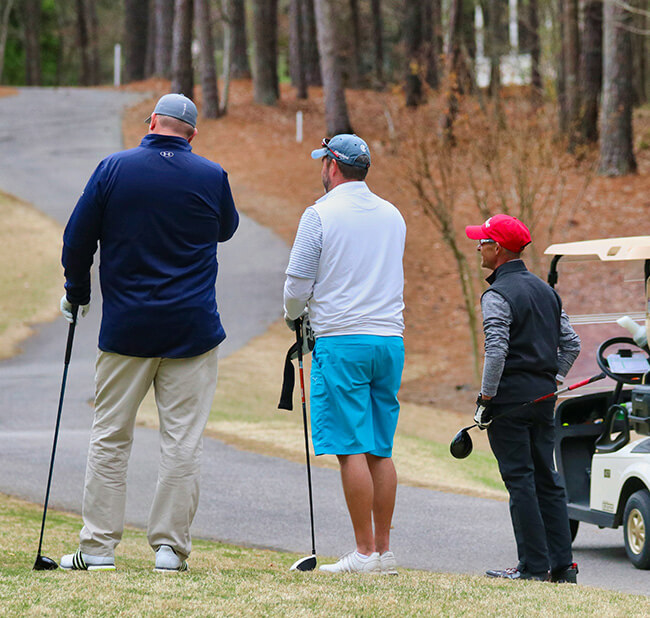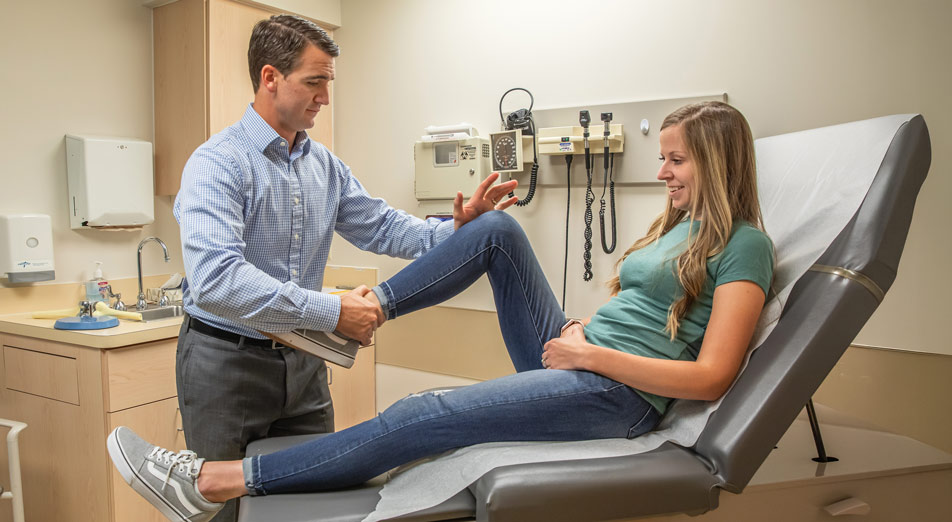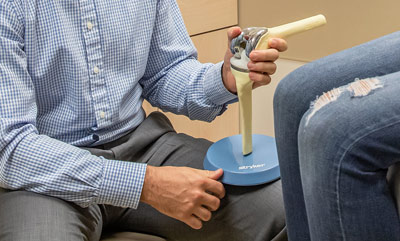Why choose Jiffy Knee replacement for a less painful, quicker recovery
Chronic knee pain can steal the joy from everyday life. When the pain becomes unbearable, many find themselves pulling back from the things they love. First, it’s the big things, like that long-awaited vacation that gets postponed indefinitely. Then, smaller moments slip away, like giving a raincheck on a friend’s invitation for a simple walk around the neighborhood.
If this sounds way too familiar and you’ve finally had enough, you’ve probably started to think more seriously about getting a new knee. As you explore your options, you may want to consider the Jiffy Knee replacement.
In this guide, Dr. Clayton Strong—one of only two surgeons in Indiana qualified to perform Jiffy Knee surgery—explains what makes it different from traditional knee replacement and shares why his patients love it. Additionally, he answers some of the questions most frequently asked about this muscle-sparing approach to knee arthroplasty. Other topics covered include:

What is a Jiffy Knee replacement?
Jiffy Knee is the name of a quad-sparing approach that can be used for partial and total knee replacement as well as knee revision surgery. Only those surgeons who have completed a specialized training program can perform the procedure.
As Dr. Strong explains, “it’s a minimally-traumatic, muscle-sparing approach” because instead of splitting the quadriceps tendon to access the joint from the front of the knee (as is done in traditional knee replacement), the Jiffy Knee approach has the surgeon make an incision from the side and work under the vastus muscle to protect the extensor mechanism. “We’re meticulous with closure—buried stitches and glue—and placing the incision over muscle helps it heal nicely and often look better.”
How is Jiffy Knee different from the traditional approach?

With a standard approach (medial parapatellar), the tendon is split. This can delay active straightening and make the first phase of rehab harder. With the Jiffy Knee quad-sparing approach, patients typically use their knees right away, allowing them to start therapy and rehabilitation almost immediately after surgery.
Regardless of the technique used to replace the knee, “what matters most is that the surgeon correctly positions the components,” says Dr. Strong. Ultimately, while the long-term outlooks are the same, “Jiffy Knee replacement offers the benefits of a less painful and quicker recovery process.”
Why proper alignment is so important
There’s no hard evidence that any alignment philosophy produces better patient outcomes, even if X-rays look different. The choice comes down to the surgeon’s preference.
In the operating room, Dr. Strong uses mechanical alignment with soft-tissue balancing because “implants are engineered and tested in a mechanically-aligned position.” He ensures proper alignment for Jiffy Knee replacements and revisions using OrthoAlign/Lantern’s handheld navigation tool, which “provides personalized, precise component alignment and soft tissue balancing.”
Jiffy Knee pros & cons
Here’s an overview of the main benefits and drawbacks of the Jiffy Knee approach to joint replacement and revision surgery.
Pro: Quicker recovery
With a Jiffy Knee replacement, the first days after surgery for patients are dramatically different from those who undergo traditional knee replacement procedures. That’s because the Jiffy Knee approach doesn’t involve cutting muscle.
“Try walking with your quad ‘blocked’ and you’ll see why the traditional start is tougher. You won’t get far, and you’ll end up leaning on a walker because you can’t straighten your leg,” says Dr. Strong.
This is because when a surgeon uses the traditional approach for knee replacement, they split the tendon, which causes the body to “shut down the quad,” says Dr. Strong. “With a standard replacement, patients can’t actively straighten their knees for about six weeks (because that’s the time it takes for the quad to heal). This delays their start to therapy and full recovery.”
After Jiffy Knee replacements, patients have more mobility. “By having quad function immediately after surgery, patients start therapy right away,” says Dr. Strong. “In roughly an hour and a half or just two hours after surgery (as soon as the anesthetic wears off), my patients can straighten their knee and begin therapy.”
“If you’re going home the same day, my team will make sure you’re walking and can safely use stairs. If you stay overnight, therapy is more aggressive the next day, and then you’ll continue at home with support arranged locally or near your home if you’re from out of state.”

Tip for swelling prevention
Knee replacement, regardless of the approach used, is a major surgery. No technique, not even the Jiffy Knee, eliminates the possibility of swelling after surgery.
Sometimes, though, Jiffy Knee patients feel so good after their procedure that they overdo it with therapy exercises, and this can cause swelling early on. While a committed, enthusiastic mindset is essential during the recovery process, pacing is even more crucial. Dr. Strong’s guidance is simple: “Do less and be consistent.”
Pro: Less pain
The approach’s “less invasiveness” often leads to less pain. While outcomes vary, around half of all Jiffy Knee replacement patients report “no pain” or “mild pain” within two weeks of surgery.
With a standard medial parapatellar approach, splitting the tendon can delay active straightening and make the first phase of rehab harder. With a quad-sparing approach like Jiffy Knee, patients typically use the quad right away, which helps jump-start therapy.
Many patients describe pain during the early days after having had a Jiffy Knee surgery as being more manageable. Despite typically being less, pain is still something patients have to deal with. “I’m straight with my Jiffy Knee replacement patients. I tell them this is going to hurt, and you still have to do the therapy,” says Dr. Strong. “Narcotics don’t take that away. What helps most is getting the quadriceps working right away and sticking with the plan.”
Tip for faster healing
Good nutrition before a Jiffy Knee replacement can make a significant difference and help prepare you for smoother, quicker healing after the procedure.
Dr. Strong encourages his patients to take a multivitamin and vitamin D as well as increase their intake of healthy foods rich in protein and calcium—so their “bodies tanks are full and have the fuel needed to recover from surgery.”
Con: Standard risks
The risks associated with the Jiffy Knee are the same as those with the traditional approach to replacement. Those basic risks include “numbness around the incision (everyone experiences that), pain, stiffness, and potential implant failure and stiffness, pain,” says Dr. Strong. But, with a Jiffy Knee, “careful closure and incision placement over the muscle can help healing go faster and also improve how the scar looks.”
Another risk that comes with any surgery is anxiety, which is why it’s so important to Dr. Strong that his patients feel as confident as possible before their procedure. “Anxiety is an emotion that produces pain, fear, and depression,” he says.
So I try to help reduce each patient’s anxiety that can start before surgery because I know this can help them a lot.
Dr. Strong
Why choose HCH for your Jiffy Knee
Five-star-rated surgeon Dr. Strong has been successfully performing Jiffy Knee replacements at Henry Community Health since 2024.

As part of Henry Community Health’s renowned team of orthopedic physicians, he approaches every patient with a teacher mindset. “Doctors shouldn’t behave like technicians. We should act like teachers and set expectations up front,” says Dr. Strong.
“It’s so important to genuinely listen when patients tell you what they need and take time to answer all their questions. I treat my patients how I would want to be treated and how I’d want a doctor to care for my loved ones.”
Schedule with Dr. Strong
Are you tired of saying “no” all the time because of knee pain? If you’re ready to start saying “yes” again, book a consultation with Dr. Strong at HCH to learn more about this quad-sparing approach to knee replacement and find out if a Jiffy Knee is right for you.
Explore more knee pain solutions at HCH
Jiffy Knee is just one of the advanced care options offered by the award-winning orthopedic specialists at HCH. Others include:
You might also like …
FAQs about the Jiffy Knee replacement procedure
When it comes to being a good candidate or not, readiness is a big deal. “The perfect patient for a Jiffy Knee replacement is the one who is miserable and has tried all non-operative treatments and not gotten relief, so they go in physically and emotionally prepared,” says Dr. Strong.
“As a surgeon, it’s important to set expectations up front. I let my patients know that Jiffy Knee replacement, even though it’s less painful, will still cause pain, and that doing therapy after is going to be a lot of work. Knowing this helps people push through the tough parts.”
He also notes following this practical rule of thumb: “If every single day you find yourself skipping out on things you want to do because of knee pain, you’ll probably benefit from having surgery. But, if you’re still doing most things or thinking about surgery because you’re chasing potential small performance gains, it usually makes sense to wait.”
“We expect each patient’s new knee to last 20–25 years. Some replacements last even longer.” Failures, if and when they occur years down the road, are often based on whether surgeons use cement when placing implant components.
During Jiffy Knee replacement surgery, Dr. Strong considers health factors and bone quality when deciding whether to use a cemented or cementless implant.
Yes! “It’s covered. Jiffy Knee has the same knee replacement code as the traditional approach,” says Dr. Strong. “There’s no difference.”
Often, yes. “If you’re healthy, your pain is controlled, and you have good help at home, patients go home the same day,” says Dr. Strong.
Note: If you’re an out-of-state patient, you’ll stay overnight so that Dr. Strong and his team can be sure there’s no clot risk before you travel home.
It depends on what you do for a living. Dr. Strong often advises his patients to request 12 weeks off, but many can return to work much sooner.
For Jiffy Knee replacement patients who are mostly sedentary at work, they can typically return after four to six weeks. People with physically demanding jobs can usually return to work after six to 12 weeks.
Every patient is different so timing may vary. That said, Dr. Strong has had patients return to activities like golf around six weeks after having had Jiffy Knee procedures.
Henry Community Health prides itself on providing our patients with several advanced techniques and technologies for knee replacements. In addition to Jiffy Knee, we offer Stryker’s Mako SmartRobotics, Persona IQ’s Smart Knee, and cementless total knee replacement. Call to schedule a consultation with an HCH knee specialist to learn more about these options and learn which might be right for you.
Dr. Strong is accepting new patients, both locally and from across the country. His team often provides care for patients from out of state.
Call to Make an Appointment With Dr. Strong
If you live too far away and don’t want to travel, you can find a trained surgeon near you using the directory tool at the official Jiffy Knee website.
Volume and outcomes matter. Ask how many total knee replacements your surgeon performs yearly. “You want to choose a specialist who does 50–100 a year,” says Dr. Strong. “With surgeons who do fewer surgeries than this, your risk of complications goes up.”
Also, ask about infection and revision rates. Facility volume matters too. You want to have surgery with a doctor whose team is familiar with knee replacement surgery, does this type of procedure routinely, and has a reputation for making fewer errors in the operating room.
Jiffy Knee is a trademarked approach. Surgeons—like Dr. Strong—undergo one-on-one training with the method’s originator. A surgeon may perform a similar subvastus technique, but without this crucial training, they can’t call what they’re doing “Jiffy Knee.”